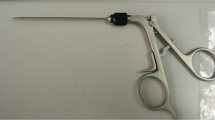Abstract
Background
Open inguinal hernia repair with high ligation is an excellent method of repair in the pediatric population. Advantages of endoscopic repairs include the ability to evaluate the contralateral side, avoidance of access trauma to the vas deferens and gonadal vessels, and decreased operative time. We now report our experience with subcutaneous endoscopically assisted ligation (SEAL), a novel technique that has proved to be a safe and effective in the treatment of inguinal hernia in the pediatric population.
Methods
The study is based on a retrospective review of 204 pediatric patients with 300 inguinal hernias treated with the SEAL technique from November 2001 to August 2003 at a tertiary referral center. Patient age ranged from 30 days to 16 years at the time of operation, with a mean follow-up of 235 days (median follow-up, 189 days). Statistical analysis was done with χ2 test, with the main outcome measures being intraoperative and postoperative complications including recurrence rate, suture abscesses, and postoperative hydroceles.
Results
There were 13 recurrences in 300 SEAL repairs, for a recurrence rate of 4.3% (95% C.I. 2.01%–6.65%), with only two recurrences in the last 100 repairs (2%). There were 10 suture abscesses or granulomas and 7 postoperative hydroceles. There was no statistically significant association between recurrence and gender, age at operation, history of prematurity, bilaterality, or kind of suture used.
Conclusions
Our 4.3% (95% C.I. 2.01–6.65%) recurrence rate is comparable to prior series of laparoscopic repairs citing recurrence rates of 0%–5.7%. The majority of recurrences occurred within the first 4 months of developing this new procedure, with only two recurrences in the last 100 repairs. These pilot data suggest that SEAL is a safe and effective technique for inguinal hernia repair in the pediatric population. A prospective study is planned to compare this laparoscopic technique with open herniorrhaphy.



Similar content being viewed by others
References
Antao B, Samuel M, Curry J, Kiely E, Drake D (2004) Comparative evaluation of laparoscopic vs. open inguinal herniotomy in infants. J Laparoendoscopic Adv Surg Tech 8: 302–309
DuBois JJ, Jenkins JR, Egan JC (1997) Transinguinal laparoscopic examination of the contralateral groin in pediatric herniorrhaphy. Surg Laparosc Endosc 7: 384–387
Gorsler CM, Schier F (2003) Laparoscopic herniorrhaphy in children. Surg Endosc 17: 571–573
Grossmann PA, Wolf SA, Hopkins JW, Paradise NF (1995) The efficacy of laparoscopic examination of the internal inguinal ring in children. J Pediatr Surg 30: 214–217; discussion 217–218
Lobe TE, Schropp KP (1992) Inguinal hernias in pediatrics: initial experience with laparoscopic inguinal exploration of the asymptomatic contralateral side. J Laparoendosc Surg 2: 135–140; discussion 141
Miltenburg DM, Nuchtern JG, Jaksic T, Kozinetiz C, Brandt ML (1998) Laparoscopic evaluation of the pediatric inguinal hernia—a meta-analysis. J Pediatr Surg 33: 874–879
Montupet P, Esposito C (1999) Laparoscopic treatment of congenital inguinal hernia in children. J Pediatr Surg 34: 420–423
Pellegrin K, Bensard DD, Karrer FM, Meagher DP Jr. (1996) Laparoscopic evaluation of contralateral patent processus vaginalis in children. Am J Surg 172: 602–605; discussion 606
Perlstein J, Du Bois JJ (2000) The role of laparoscopy in the management of suspected recurrent pediatric hernias. J Pediatr Surg 35: 1205–1208
Prasad R, Lovvorn HN 3rd, Wadie GM, Lobe TE (2003) Early experience with needleoscopic inguinal herniorrhaphy in children. J Pediatr Surg 38: 1055–1058
Rescorla FJ, West KW, Engum SA, Scherer LR 3rd, Grosfeld JL (1997) The “other side” of pediatric hernias: the role of laparoscopy. Am Surg 63: 690–693
Rogers DA, Hatley RM, Howell CG Jr (1998) A prospective, randomized comparison of traditional and laparoscopic inguinal exploration in children. Am Surg 64: 119–121
Rowe MI, Copelson LW, Clatworthy HW (1969) The patent processus vaginalis and the inguinal hernia. J Pediatr Surg 4: 102–107
Schier F (1998) Laparoscopic herniorrhaphy in girls. J Pediatr Surg 33: 1495–1497
Schier F (2000) Laparoscopic surgery of inguinal hernias in children—initial experience. J Pediatr Surg 35: 1331–1335
Schier F, Danzer E, Bondartschuk M (2001) Incidence of contralateral patent processus vaginalis in children with inguinal hernia. J Pediatr Surg 36: 1561–1563
Schier F, Montupet P, Esposito C (2002) Laparoscopic inguinal herniorrhaphy in children: a three-center experience with 933 repairs. J Pediatr Surg 37: 395–397
Shalaby R, Desoky A (2002) Needlescopic inguinal hernia repair in children. Pediatr Surg Int 18: 153–156
Stylianos S, Jacir NN, Harris BH (1993) Incarceration of inguinal hernia in infants prior to elective repair. J Pediatr Surg 28: 582–583
Tackett LD, Breuer CK, Luks FI, Caldamone AA, Breuer JG, DeLuca FG, Caesar RE, Efthemiou E, Wesselhoeft CW Jr (1999) Incidence of contralateral inguinal hernia: a prospective analysis. J Pediatr Surg 34: 684–687; discussion 687–688
Weber R, Trazy T, Keller M (2005) Groin hernias and hydroceles. In: Ashcraft K, Holcomb G, Murphy J (eds), Pediatric Surgery, 4th Edition, Mosby-Yearbook, St. Louis MO
Wulkan ML, Wiener ES, VanBalen N, Vescio P (1996) Laparoscopy through the open ipsilateral sac to evaluate presence of contralateral hernia. J Pediatr Surg 31: 1174–1176; discussion 1176–1177
Acknowledgments
We thank Tiffany Townsend for valuable discussions and contribution to the literature review. We also thank Anita Kris for assistance with data entry and Vilma Zarate for assistance with figures and final manuscript preparation.
Author information
Authors and Affiliations
Corresponding author
Rights and permissions
About this article
Cite this article
Ozgediz, D., Roayaie, K., Lee, H. et al. Subcutaneous endoscopically assisted ligation (SEAL) of the internal ring for repair of inguinal hernias in children: report of a new technique and early results. Surg Endosc 21, 1327–1331 (2007). https://doi.org/10.1007/s00464-007-9202-3
Received:
Accepted:
Published:
Issue Date:
DOI: https://doi.org/10.1007/s00464-007-9202-3




